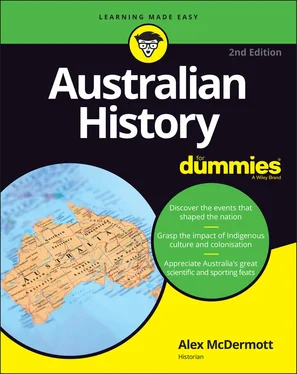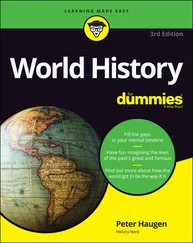Massive economic expansion went with settlement expansion, as Macquarie ordered the building of roads, public buildings and even parks to be commenced.
Shortly after arriving in the colony, Macquarie wrote to Britain, asking for more convicts to be sent out. Previous governors had asked for specific trades (for example, ‘Send more carpenters!’) but Macquarie was the first to ask for more, full stop, arguing, ‘The prosperity of the Country depends on their numbers’. He also abandoned government farming, thinking economic improvement was more likely with private settlers. (He would be forced to bring government farming back later in his administration, due to circumstances outside his control; see ‘ Coping with the deluge following Waterloo’ later in this chapter.)
 Under this scheme of rapid economic expansion, the skilled manual labourers — masons, builders, blacksmiths, sawyers, splitters, fencers and carpenters — continued to be the worker ‘aristocracy’, earning exceedingly good wages. The unskilled variously became house servants, wharfies, quarry-workers, farmhands, assistants in offices and warehouses, or workers in the small manufacturing workshops that were proliferating.
Under this scheme of rapid economic expansion, the skilled manual labourers — masons, builders, blacksmiths, sawyers, splitters, fencers and carpenters — continued to be the worker ‘aristocracy’, earning exceedingly good wages. The unskilled variously became house servants, wharfies, quarry-workers, farmhands, assistants in offices and warehouses, or workers in the small manufacturing workshops that were proliferating.
Conciliating (and pursuing) Indigenous Australians
Macquarie was keen to make his mark with the Aboriginal community as well.
In October 1814, Macquarie wrote to Lord Bathurst in the Colonial Office, suggesting an Aboriginal school be established in Parramatta as part of an endeavour to win the hearts and minds of the younger Aboriginal generation, and to persuade the parents to allow their children to learn some of the European ways, of cultivation, literacy and sedentary ‘civilised’ society. On receiving Bathurst’s approval, the school was soon in place. (Parents, however, removed children from the school after they realised its aim was to distance the children from their culture and families.)
Macquarie’s attempt to conciliate Aboriginal peoples was also manifested a few months later, when he held the first of what would become an annual ‘gathering of tribes’ in Parramatta. Here, Macquarie played the ‘big chief’ (he fancied himself as a bit of a Scottish Highland chieftain), handing out gifts and good humour to Indigenous Australians who travelled up to three hundred kilometres to attend the gathering.
 Macquarie wanted all those beneath him to prosper — both convicts and Aboriginal people — as long as they acknowledged they were beneath him in rank and authority. Macquarie wasted little time mounting punitive military expeditions when some Aboriginals seemed set to continue their ‘perverse’ hostility to his good intentions and the settlement at large. In 1816, after Aboriginal attacks on farms on the outskirts of the Sydney settlement, Governor Macquarie sent a party to arrest the offenders. This resulted in an attack on an Aboriginal camp at Appin, and the killing of 14 Aboriginal people, none of them known to have been involved in the initial incident.
Macquarie wanted all those beneath him to prosper — both convicts and Aboriginal people — as long as they acknowledged they were beneath him in rank and authority. Macquarie wasted little time mounting punitive military expeditions when some Aboriginals seemed set to continue their ‘perverse’ hostility to his good intentions and the settlement at large. In 1816, after Aboriginal attacks on farms on the outskirts of the Sydney settlement, Governor Macquarie sent a party to arrest the offenders. This resulted in an attack on an Aboriginal camp at Appin, and the killing of 14 Aboriginal people, none of them known to have been involved in the initial incident.
Macquarie declared individual Aboriginals as wanted outlaws when whites and blacks clashed, and declared martial law on both Aboriginals and bushrangers when needed in regions where conflict was most rife.
Re-ordering a town, re-ordering convict behaviour
Macquarie may have been impressed with the industry evident in the new colony of NSW, but he still believed things should be done in a certain (ordered and moral) way. Although not really in the way instructed by the Colonial Office, Macquarie did introduce some order to the settlement.
Introducing order to Sydney’s layout
Macquarie proved himself different from the previous governor (Governor Bligh) when he was able to refashion the town of Sydney without residents threatening him with revolution. Unlike Bligh, who called into question ordinary people’s property rights and threatened them with summary eviction (refer to Chapter 4), Macquarie was able to impose change in a way that seemed orderly rather than arbitrary.
In October 1810, a new town plan was introduced for Sydney, which included new street names, washhouses, widened roads — and the creation of a certain Macquarie Place. A month later, it was announced that a brand new hospital was to be built (for the price of a five-year rum trading monopoly to the three men who promised to build it — pragmatism in action!). A year later further plans were introduced, including a new animal pound and a turnpike on the Parramatta Road. These were followed by a lighthouse on South Head, a new fort, and plenty more churches — with a very large fountain in Sydney topping it all off.
Macquarie ensured that whatever came next in the colony, no-one was going to forget him in a hurry. His mark would be evident everywhere, on maps and on buildings, roads and other structures. As a result, the shanty metropolis began to show a lot more orderliness.
HELLO NSW: CALL ME LACHLAN, AND I’LL CALL EVERYTHING MACQUARIE
Macquarie made a lasting impact on life in Australia — and on maps in Australia. He made sure he was remembered by naming things after himself, and encouraging others (explorers, surveyors, builders and designers) to do the same. Here Macquarie didn’t stint.
In Australia today you can find Macquarie
Lakes
Rivers
Lighthouses
Harbours
Piers
Hills
Fields
Passes
Marshes
Islands
Pubs
You name it — Macquarie’s name will be on it.
Introducing order to the population’s behaviour
Macquarie was keen to introduce orderliness to all aspects of colonial life, and so he encouraged the general population to settle down in their behaviour and lives.
Hundreds of men and women were living in ‘common-law marriages’, or what are known today as de facto relationships (and what shocked Evangelical ministers at the time called the keeping of ‘concubines’!). Macquarie tried to get men and women to make it all official, in a church, with the registry. This was part of his plan to make the whole colony more settled, along with his building of churches and encouragement of schools.
Macquarie was also strict in his treatment of convicts. Even though he liked nothing more than helping ex-convicts attain the social prominence that their material wealth and industrious activity had (in his eyes at least) earned them, that didn’t mean he thought convicts should be allowed to do whatever they wanted.
In 1814, Macquarie declared sternly that convicts could no longer swap between masters. If a neighbouring settler offered you a better deal, more free time or more pay, tough — you had to stick with the master you’d been assigned to.
Macquarie took his control of convicts further in 1819 when, to groans from convicts all round, the Hyde Parke Barracks opened.
 In a pretty clear illustration of the power dynamics in the early colony, Macquarie couldn’t just order the convicts into the new barracks. Many convicts would have preferred to continue living wherever they’d already found lodgings — staying with their mates or a nice landlady perhaps. So Macquarie threw a big feast — offering the convicts a party, with plenty of rum — and the convicts fell for it. In they went, with the big door locked behind them.
In a pretty clear illustration of the power dynamics in the early colony, Macquarie couldn’t just order the convicts into the new barracks. Many convicts would have preferred to continue living wherever they’d already found lodgings — staying with their mates or a nice landlady perhaps. So Macquarie threw a big feast — offering the convicts a party, with plenty of rum — and the convicts fell for it. In they went, with the big door locked behind them.
Читать дальше

 Under this scheme of rapid economic expansion, the skilled manual labourers — masons, builders, blacksmiths, sawyers, splitters, fencers and carpenters — continued to be the worker ‘aristocracy’, earning exceedingly good wages. The unskilled variously became house servants, wharfies, quarry-workers, farmhands, assistants in offices and warehouses, or workers in the small manufacturing workshops that were proliferating.
Under this scheme of rapid economic expansion, the skilled manual labourers — masons, builders, blacksmiths, sawyers, splitters, fencers and carpenters — continued to be the worker ‘aristocracy’, earning exceedingly good wages. The unskilled variously became house servants, wharfies, quarry-workers, farmhands, assistants in offices and warehouses, or workers in the small manufacturing workshops that were proliferating. Macquarie wanted all those beneath him to prosper — both convicts and Aboriginal people — as long as they acknowledged they were beneath him in rank and authority. Macquarie wasted little time mounting punitive military expeditions when some Aboriginals seemed set to continue their ‘perverse’ hostility to his good intentions and the settlement at large. In 1816, after Aboriginal attacks on farms on the outskirts of the Sydney settlement, Governor Macquarie sent a party to arrest the offenders. This resulted in an attack on an Aboriginal camp at Appin, and the killing of 14 Aboriginal people, none of them known to have been involved in the initial incident.
Macquarie wanted all those beneath him to prosper — both convicts and Aboriginal people — as long as they acknowledged they were beneath him in rank and authority. Macquarie wasted little time mounting punitive military expeditions when some Aboriginals seemed set to continue their ‘perverse’ hostility to his good intentions and the settlement at large. In 1816, after Aboriginal attacks on farms on the outskirts of the Sydney settlement, Governor Macquarie sent a party to arrest the offenders. This resulted in an attack on an Aboriginal camp at Appin, and the killing of 14 Aboriginal people, none of them known to have been involved in the initial incident.










